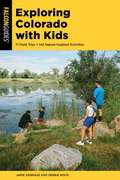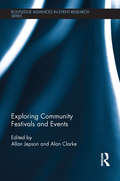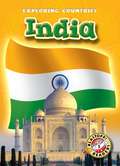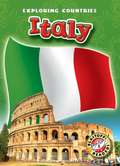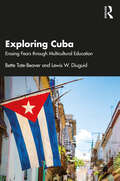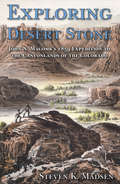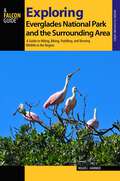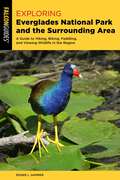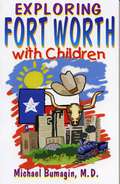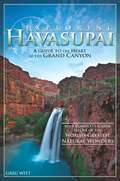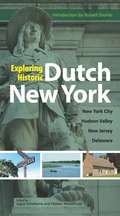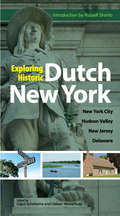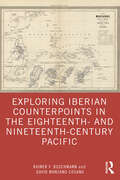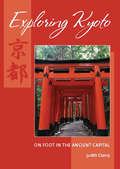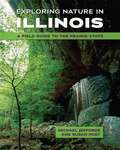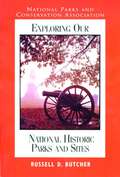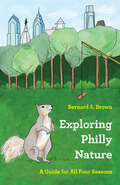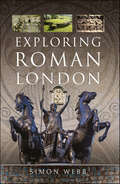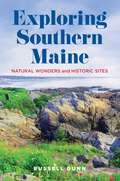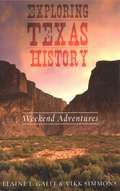- Table View
- List View
Exploring Colorado with Kids: 71 Field Trips + 142 Nature-Inspired Activities
by Jamie Siebrase Deborah MockAre you ready to experience Colorado&’s best outdoors destinations for families? What are you waiting for?There&’s so much more to the Colorado outdoors scene than skiing, hiking, and mountain biking. Between Fort Collins and Colorado Springs, from the sprawling, golden plains to Summit County&’s snow-capped peaks, this unique guidebook introduces families to an exciting range of outdoorsy adventures. Travel journalists and local parenting experts Jamie Siebrase and Deborah Mock will guide you and your children through 71 incredible, in-state adventures. Get ready to discover nature centers, farms, outdoor history museums, art walks, hidden SUP spots, open-air theaters, story walks, and so much more. The destinations laid out in this book are pure fun —but don&’t be surprised if you and your kids learn a few educational tidbits along the way. The book&’s 71 chapters are short and punchy with great writing and beautiful B&W photographs. Each section includes a short section with action-item information on each site. This is an informative guide to discovering a variety of outdoor adventures that are a perfect fit for family weekends and getaways.
Exploring Community Festivals and Events (Routledge Advances in Event Research Series)
by Alan Clarke Allan JepsonThe development of the festival and event industry has seen large scale growth and extensive government support as a result of objectives to enhance and project the image of place and leverage positive sponsorship and regeneration opportunities. As we move deeper into austerity measures prompted by economic recession, community festivals and events as a sacred or profane time of celebration can be considered even more important than ever before. This book for the first time explores the role and importance of ‘community’, ‘culture’ and its impact through festivals and events. Split into two distinct sections, the first introduces key themes and concepts, contextualises local traditions and culture, and investigates how festivals and events can act as a catalyst for tourism and create a sense of community. It then questions the social and political nature of festivals and community events through examining their ownership. The second section focuses on communities themselves, seeking to examine and discuss key emerging themes in community event studies such as; the role of diaspora, imagined communities, pride and identity, history, producing and consuming space and place, authenticity, and multi-ethnic communities. Examples are drawn from Portugal, the Dominican Republic, the USA, Malaysia, Malta, Finland and Australia making this book truly international. This significant volume will be valuable reading for students and academics across the fields of Event, Tourism and Hospitality studies as well as other social science disciplines.
Exploring Countries India
by Jim BartellDeveloped by literacy experts for students in grades three through seven, this book introduces young readers to the geography and culture of India.
Exploring Countries: Italy
by Walter SimmonsBlastoff! Readers are carefully developed by literacy experts and combine standards-based content with developmentally appropriate text. Sticking out into the Mediterranean Sea, Italy has some of the nicest weather in Europe. It is famous for its art, architecture, and cuisine. Readers will discover the physical geography of Italy through descriptions of the landscape, waters, and coasts. They will also learn about the cultural geography of Italy, reading about Italian schools, businesses, and communities.
Exploring Cuba: Erasing Fears through Multicultural Education
by Bette Tate-Beaver Lewis W. DiuguidExploring Cuba: Erasing Fears Through Multicultural Education details the cultural and professional exchanges to Cuba organized by the National Association of Multicultural Education (NAME) between 2015 and 2019, with additional reflections on the impact of the coronavirus pandemic on Cuba—U.S. relations. Because of the long-imposed U.S. embargo, or blockade, access to information about life in Cuba can be limited in the U.S. This book chronicles first-hand account of NAME’s trips to Cuba over a 5-year period. Interspersed with insights from U.S.-based multicultural educators, authors and Cuban delegates, it documents what NAME members learned about Cuba’s people, history, health care system, culture, arts, and education systems. It also explores the effects of the coronavirus global pandemic on Cuba and its vital tourist industry, as well as the July 2021 protests and aftermath, including a new wave of immigration to the U.S. The book argues for the end of the U.S. embargo with Cuba and the normalization of diplomatic relations between the two countries, so that unrestricted tourism and trade can benefit both countries. Combining travelogue observations with statistics and scholarly accounts, this volume will be useful reading for scholars and students of Multicultural Education, International Education and Comparative Education. It will also be beneficial to educators and Cuba solidarity activists.
Exploring Dallas with Children: A Guide for Family Activities
by Kay McCasland ThreadgillGrab the kids and explore Dallas-Fort Worth where there are tons of fun activities for families to enjoy together. From Six Flags Over Texas to the Mesquite Rodeo, this is the most complete and up-to-date guide for family fun. Highlights include: parks, museums, farms, performing arts and concerts, sports and recreation parks, festivals, day trips, rainy weather ideas, birthday party ideas, and lists of free activities. Whatever activity you and your family are looking for, you are bound to find it here!
Exploring Desert Stone
by Steven K. MadsenThe confluence of the Green and Colorado Rivers, now in Canyonlands National Park, near popular tourist destination Moab, still cannot be reached or viewed easily. Much of the surrounding region remained remote and rarely visited for decades after settlement of other parts of the West. The first U. S. government expedition to explore the canyon country and the Four Corners area was led by John Macomb of the army's topographical engineers. The soldiers and scientists followed in part the Old Spanish Trail, whose location they documented and verified. Seeking to find the confluence of the Colorado and the Green and looking for alternative routes into Utah, which was of particular interest in the wake of the Utah War, they produced a substantial documentary record, most of which is published for the first time in this volume. Theirs is also the first detailed map of the region, and it is published inExploring Desert Stone, as well.
Exploring Desert Stone: John N. Macomb's 1859 Expedition to the Canyonlands of the Colorado
by Steven K. MadsenThe confluence of the Green and Colorado Rivers, now in Canyonlands National Park, near popular tourist destination Moab, still cannot be reached or viewed easily. Much of the surrounding region remained remote and rarely visited for decades after settlement of other parts of the West. The first U.S. government expedition to explore the canyon country and the Four Corners area was led by John Macomb of the army's topographical engineers. The soldiers and scientists followed in part the Old Spanish Trail, whose location they documented and verified. Seeking to find the confluence of the Colorado and the Green and looking for alternative routes into Utah, which was of particular interest in the wake of the Utah War, they produced a substantial documentary record, most of which is published for the first time in this volume. Theirs is also the first detailed map of the region, and it is published in Exploring Desert Stone, as well.
Exploring Everglades National Park and the Surrounding Area: A Guide to Hiking, Biking, Paddling, and Viewing Wildlife in the Region (Exploring Series)
by Roger L. HammerThis is the ultimate guide to discovering the vast "River of Grass" ecoregion of the southern Florida mainland. Packed with photographs, maps, and informative text, this guide will help outdoor enthusiasts appreciate the landscape and varied flora and fauna of this watershed whether they have a day to spend in the effort or a lifetime. This edition includes new routes in Biscayne National Park. Whether traveling by canoe or by foot, this guide will enhance the next journey into the remarkable Everglades.
Exploring Everglades National Park and the Surrounding Area: A Guide to Hiking, Biking, Paddling, and Viewing Wildlife in the Region (Exploring Series)
by Roger L. HammerThis is the ultimate guide to discovering the vast "River of Grass" ecoregion of the southern Florida mainland. Packed with photographs, maps, and informative text, this guide will help outdoor enthusiasts appreciate the landscape and varied flora and fauna of the watershed whether they have a day to spend in the effort or a lifetime. This edition includes new routes in the Biscayne National Park. Whether traveling by canoe or by foot, this guide will enhance the next journey into the remarkable Everglades.
Exploring Fort Worth With Children
by Michael S. BumaginCome to where the west begins! Fort Worth is a big city with a hometown heart and a YHowdy, neighbor? attitude. Visitors from all parts of the world and of all ages can find something here to interest and excite them. Take a look at some of the fun things to see and do in Cowtown USA: The StockyardsFort Worth ZooBass Performance HallCasa MananaTarantula TrainWater GardensKimbell Art MuseumAmon Carter MuseumTrinity ParkBotanic GardenSports and athletic eventsLibraries and bookstoresShopping mallsIce skating, bowling, golfLakes and parksHorseback riding and lots moreThis handy guide includes helpful information about cultural events, live theater and movies, churches, places to eat, places to stay, where to go for planning a party, emergency numbers, and day trips to surrounding areas. Michael Bumagin, M.D., is a Fort Worth plastic and reconstruction surgeon. He has been a docent at the Fort Worth Zoo and the Museum of Science and History.
Exploring Havasupai
by Greg WittDeep in the Grand Canyon lies a place of unmatched beauty; a place where blue-green water cascades over fern-clad cliffs into travertine pools, where great blue heron skim canyon streams, and where giant cottonwoods and graceful willows thrive in the shade of majestic sandstone cliffs. Havasupai is a paradise enveloped in one of the earth's most rugged and parched landscapes. The Havasupai Tribe has never advertised its canyon and has never endorsed a guidebook to prepare visitors for a journey into the Heart of the Grand Canyon - until now. Exploring Havasupai is the essential destination guide for those visiting the area. The guidebook is filled with insider tips, fascinating background, and essential information. It identifies many new hikes, mines, springs and historical sites never before revealed in a Grand Canyon or Havasupai guidebook. Details on canyon geology, weather patterns, and the unique flora and fauna add depth to a hiker's experience. Exploring Havasupai includes detailed maps, trail descriptions, stunning full-color photographs, and intriguing historical insights. This is the must-have guide for canyon visitors, whether arriving by helicopter, on horseback, or on foot.
Exploring Historic Dutch New York: New York City * Hudson Valley * New Jersey * Delaware
by Russell Shorto Heleen Westerhuijs Gajus Scheltema"The Dutch spirit of diversity, tolerance, and entrepreneurship still echoes across our city streets today. This guide will highlight the history of the early settlements of these new world pioneers as well as the incredible impact they had, and still have, on the world's greatest city." -- Michael R. Bloomberg, Mayor, City of New YorkThis comprehensive guide to touring important sites of Dutch history serves as an engrossing cultural and historical reference. A variety of internationally renowned scholars explore Dutch art in the Metropolitan Museum, Dutch cooking, Dutch architecture, Dutch immigration in the nineteenth and twentieth centuries, English words of Dutch origin, Dutch furniture and antiques, and much more. Color photographs and maps throughout. "An expansive guidebook inspired by the Henry Hudson quadricentennial and accompanied by informative essays." -- The New York Times
Exploring Historic Dutch New York: New York City * Hudson Valley * New Jersey * Delaware (New York City Ser.)
by Russell Shorto Heleen Westerhuijs Gajus Scheltema"The Dutch spirit of diversity, tolerance, and entrepreneurship still echoes across our city streets today. This guide will highlight the history of the early settlements of these new world pioneers as well as the incredible impact they had, and still have, on the world's greatest city." — Michael R. Bloomberg, former Mayor, City of New York <P><P> This comprehensive guide to touring important sites of Dutch history serves as an engrossing cultural and historical reference. A variety of internationally renowned scholars explore Dutch art in the Metropolitan Museum, Dutch cooking, Dutch architecture, Dutch immigration in the nineteenth and twentieth centuries, English words of Dutch origin, Dutch furniture and antiques, and much more. Color photographs and maps throughout.
Exploring Iberian Counterpoints in the Eighteenth- and Nineteenth-Century Pacific
by Rainer F. Buschmann David Manzano CosanoThrough a number of significant case studies, this volume examines changing Iberian dynamics in the Pacific, bridging the gaps between English and Spanish speaking scholarship to highlight understudied actors and debates in the eighteenth and nineteenth centuries. The book shifts the predominant emphasis on Anglo-American studies and the historical neglect of Iberian endeavors in this ocean by focusing on several episodes that illuminate Spanish engagement in the Pacific. It describes Spain’s treatment of this sea from its discovery to the end of the overseas empire in 1899, becoming the first book to place its analytical focus in the heart of the islands rather than the Pacific Rim. In tracing shifting Spanish positions and policies, the book cautions against making generalities about the distinct histories of Pacific islands and their Indigenous populations, uncovering a much more heterogeneous world than previous research may convey. Exploring Iberian Counterpoints in the Eighteenth- and Nineteenth-Century Pacific is the perfect resource for students and researchers of the Iberian world, Hispanic studies, and the Pacific Ocean in early modern and modern eras.
Exploring Kyoto
by Judith Clancy"Exploring Kyoto by long-term resident Judith Clancy is an excellent guide to exploring Kyoto on foot." -Lonely Planet Japan Among the world's most cherished ancient cities, Kyoto, Japan, is perfect for exploring on foot. Richly detailed and small enough to fit in a jacket pocket, Exploring Kyoto is an essential guide to becoming an enlightened pedestrian in the area once known as Yamashiro ("the back of the mountains"). Thoroughly revised and updated, this edition of Exploring Kyoto offers two new routes and spans a spectrum of geographical and cultural topography, from bustling downtown quarters to remote mountaintops, hip eateries to ancient shrines. Included are:* Thirty explorations, including the well-known-Mt. Hiei, Arashiyama, Heian Shrine, Ryoanji, Philosopher's Walk-and many hidden corners* Detailed maps tracing each route* Over thirty descriptive photos Essential tips on etiquette and behavior* Full index to all sites and attractions* In-depth information on local history, arts, and festivals
Exploring Lewis and Clark: Reflections on Men and Wilderness
by Thomas P. SlaughterMost Americans know that Meriwether Lewis and William Clark led our nation's first trans-continental exploratory expedition, which was sent west by President Thomas Jefferson in 1803. Their journey is one of the most celebrated events in American history and one of the most written about. But most of us do not know any more than what the explorers told us, or what they wanted readers of their voluminous journals to know, or anything other than what they understood about themselves and their wilderness experiences. Exploring Lewis and Clark probes beneath the traditional narrative of the journey, looking beyond the perspectives of the explorers themselves to those of the woman and the men who accompanied them, as well as of the Indians who met them along the way. It reexamines the journals and what they suggest about Lewis's and Clark's misinterpretations of the worlds they passed through and the people in them. Thomas Slaughter portrays Lewis and Clark not as heroes but as men--brave, bound by cultural prejudices and blindly hell-bent on achieving their goal. He searches for the woman Sacajawea rather than the icon that she has become. He seeks the historical rather than the legendary York, Clark's slave. He discovers what the various tribes made of the expedition, including the notion that this multiracial, multiethnic group was embarked on a search for spiritual meaning. Thomas Slaughter shines an entirely new light on an event basic to our understanding of ourselves. He has given us an important work of investigative history.
Exploring Nature in Illinois: A Field Guide to the Prairie State
by Susan Post Michael JeffordsLoaded with full color photographs and evocative descriptions, Exploring Nature in Illinois provides a panorama of the state's overlooked natural diversity. Naturalists Michael Jeffords and Susan Post explore fifty preserves, forests, restoration areas, and parks, bringing an expert view to wildlife and landscapes and looking beyond the obvious to uncover the unexpected beauty of Illinois's wild places. From the colorful variety of birds at War Bluff Valley Audubon Sanctuary to the exposed bedrock and cliff faces of Apple River Canyon, Exploring Nature in Illinois will inspire readers to explore wonders hidden from urban sprawl and cultivated farmland. Maps and descriptions help travelers access even hard-to-find sites while a wealth of detail and photography offers nature-lovers insights into the flora, fauna, and other aspects of vibrant settings and ecosystems. The authors also include diary entries describing their own impressions of and engagement with the sites. A unique and much-needed reference, Exploring Nature in Illinois will entertain and enlighten hikers, cyclers, students and scouts, morning walkers, weekend drivers, and anyone else seeking to get back to nature in the Prairie State.
Exploring Our National Parks and Sites
by Russell D. ButcherThe essential guide to the land and history of the US national historical parks and sites. It is the sequel to Exploring National Parks and Monuments.
Exploring Philly Nature: A Guide for All Four Seasons
by Bernard S. BrownDo snakes and salamanders fascinate you or make you squeamish? Have you ever listened closely to the birds chirping in your neighborhood? Can you identify the flowers growing in Philadelphia’s urban parks? (Moreover, are the mushrooms safe to eat?) Exploring Philly Nature is amateur naturalist, urban herper,* and Grid contributor Bernard Brown’s handy guide to experiencing the flora and fauna in Philly. This compact illustrated volume contains 52 activities from birding, (squirrel) fishing, and basement bug-hunting to joining a frog call survey and visiting a mussel hatchery. Brown encourages kids (as well as their parents) to connect with the natural world close to home. Each entry contains information on where and when to participate, what you will need (even if it is only patience), and tips on clubs and organizations to contact for access. The city and its environs contain a multitude of species from the lichen that grows on gravestones or trees to nocturnal animals like opossums, bats, and raccoons. Exploring Philly Nature is designed to get readers eager to discover, observe, and learn more about the concrete jungle that is Philadelphia.
Exploring Philly Nature: A Guide for All Four Seasons
by Bernard S. BrownDo snakes and salamanders fascinate you or make you squeamish? Have you ever listened closely to the birds chirping in your neighborhood? Can you identify the flowers growing in Philadelphia’s urban parks? (Moreover, are the mushrooms safe to eat?) Exploring Philly Nature is amateur naturalist, urban herper,* and Grid contributor Bernard Brown’s handy guide to experiencing the flora and fauna in Philly. This compact illustrated volume contains 52 activities from birding, (squirrel) fishing, and basement bug-hunting to joining a frog call survey and visiting a mussel hatchery. Brown encourages kids (as well as their parents) to connect with the natural world close to home. Each entry contains information on where and when to participate, what you will need (even if it is only patience), and tips on clubs and organizations to contact for access. The city and its environs contain a multitude of species from the lichen that grows on gravestones or trees to nocturnal animals like opossums, bats, and raccoons. Exploring Philly Nature is designed to get readers eager to discover, observe, and learn more about the concrete jungle that is Philadelphia.
Exploring Roman London
by Simon WebbDiscover the secrets of Roman London with this invaluable and lavishly illustrated travel companion that blends history and self-guided walks to explore all visible Roman remains throughout Greater London. Much more than a simple guidebook, Exploring Roman London is an indispensable guide for anyone interested in the early history of England's capital city. In addition to containing information on every site in London where Roman remains can be seen, the history of the foundation of the city and its subsequent development is meticulously chronicled. Each chapter deals with a different aspect of the first incarnation of London, when the invading Romans established their settlement in the 1st century CE. Even those who pride themselves on their knowledge of the city will find much here which is new to them, as street-by-street instructions for self-guided walks around central London allow those interested to follow the hidden rivers and lost roads of the Roman town. Exploring Roman London describes the many fragments of Roman London on open display in the city, most of which are quite unknown to the average citizen. From the huge statue of Minerva which was standing unnoticed in a churchyard until two years ago, to the Roman house which lies in a church crypt, this book will allow anyone curious about London's history to examinethe archaeology for themselves.
Exploring Southern Appalachian Forests
by Thomas R. Wentworth Stephanie B. JeffriesThis unique hiking guide to the southern Appalachian mountains leads readers to explore the rich forest ecosystems and other natural communities visitors encounter along the trail. Drawing on years of experience guiding forest walks throughout the region, Steph Jeffries and Tom Wentworth invite hikers and nature lovers to see their surroundings in new ways. Readers will learn to decipher clues from the tree canopies, forest floor, and other natural features to appreciate more fully the environmental factors that make the southern Appalachians home to an amazing biodiversity.These thirty popular hikes in Virginia, North Carolina, South Carolina, Tennessee, and Georgia range from short walks along Blue Ridge Parkway pull-offs to longer day trips in the region's backcountry. Offering spectacular mountain scenery and natural wildflower gardens, these trails are the perfect place to gain a new appreciation for the natural communities of the region.Features include* A summary including distance, difficulty, and GPS coordinates for each hike* A narrative description of each hike, including the unique natural features waiting to be discovered* Detailed instructions to keep you on the trail* Best seasons to go for wildflower and foliage views* Contact information for each area* Photos and maps to orient you* An illustrated guide to southern Appalachia's most common trees and shrubs, including tips on identification
Exploring Southern Maine: Natural Wonders and Historic Sites
by Russell DunnExploring the Southern Maine coast and interior from Kittery to Portland, this eclectic book guides readers to geological points of interest such as waterfalls, glacial boulders, rock profiles, and towering cliff views; to historic houses, garrisons, and mansions; to hiking trails and scenic walkways; to museums, historic churches, and nineteenth-century libraries; to beaches, rivers, parks, and launch sites for cartop watercraft; and to golf courses. Brief descriptions provide just enough information to whet your curiosity without giving anything away and GPS coordinates make sure you don't get lost.
Exploring Texas History: Weekend Adventures
by Elaine L. Galit Vikk SimmonsCombining fascinating stories of Texas history with travel adventures around the state, Exploring Texas History: Weekend Adventures suggests where to go and what to see by tracking historical characters and events. The travel destinations echo the settlement of Texas, the battle for independence, the Alamo, cowboys, vacqueros, Buffalo Soldiers, shipwrecks, and cattle drives. Each chapter includes history, travel routes, best sights, best times to visit, lodging, dining, and sources for additional information. Families, visitors, travelers with a love of history, and teachers and students studying the required curriculum of the fourth grade in Texas schools will find this guide practical and user friendly.
